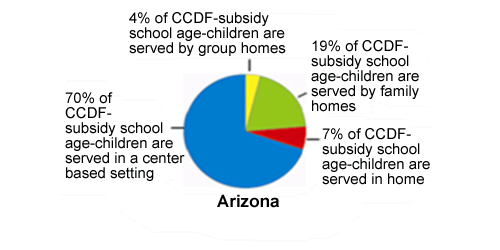|
The Afterschool Investments project has developed profiles for each state to provide a snapshot of the "state of afterschool," as well as an opportunity to compare afterschool activities across the country. This profile provides key data and descriptions of the afterschool landscape, which includes a range of out-of-school time programming that can occur before and after school, on weekends, and during summer months. It is designed to serve as a resource for policymakers, administrators, and providers.
Quick Facts
Demographics
| Total population: |
6,166,318 |
Number of children ages 5-12:
|
703,379 |
| Percent of population: |
11.4% |
Percent of students eligible for free and reduced-price lunch:
|
47.3% |
Percent of K-12 students in Title I "Schoolwide" schools:
|
32.8% |
For more demographic information, visit http://nccic.acf.hhs.gov/statedata/statepro/index.html
Child Care and Development Fund (CCDF)
• CCDF Administrative Overview
Administering agency: |
Department of Economic Security,
Child Care Administration
|
Total FFY06 federal and state CCDF funds: |
$133,930,842 |
FFY06 total federal share: |
$106,032,716 |
FFY06 state MOE plus match: |
$27,898,126 |
FFY06 School Age & Resource and Referral Targeted Funds: |
$434,156 |
FFY06 Tribal CCDF Allocation:
|
$15,014,565 |
FFY05 Total Quality Expenditures: |
$12,618,141 |
Percent of children receiving CCDF subsidies who are ages
5-12: |
45.7% |
• Settings

Where CCDF-Subsidy school age-children are served:
| In a center based setting |
70% |
| By group homes |
4% |
| By family homes |
19% |
| In home |
7% |
• Uses of CCDF Targeted Funds and Quality Dollars for Afterschool
"Resource and referral and school-age" targeted funds:
Funds can be used to provide training and technical assistance for school-age providers. Additionally, the Governor’s Office for Children, Youth, and Families may collaborate with community groups to provide out-of school time programs targeted to adolescents ages 11-14. A "Phone Friend" program will also be developed to provide children who are at home alone a "warm line" to access caring adults.
Other quality activities:
Providers that are pursuing national accreditation may receive enhanced training, technical assistance, and mini-grants. Specialized training may also be offered to providers serving special needs school-age children.
• Provider Reimbursement Rates
Label assigned by state for school-age rate category: |
6 years to less than 13 years |
Maximum rate for center-based school-age category: |
$22/day |
Notes: District 1 given, which is the Maricopa county (greater Phoenix area). |
Standardized monthly center-based school-age rate: |
$300 |
Are separate subsidy rates offered for part-time and full-time care? |
Yes |
Tiered Reimbursement Rate System:
For licensed providers, an enhanced
rate (up to 10%) above maximum
rate is available if national accreditation
standards are met.
Temporary Assistance for Needy Families (TANF) and Child Care
FFY05 state TANF transfer to CCDF: |
$0 |
FFY05 TANF direct spending on child care:
|
-$109,118 |
Program Licensing and Accreditation Policies
| Are there separate licensing standards governing the care of school-age children? |
No |
Are there specialized requirements for center-based care for school-age children? |
Yes |
Ratio of children to adults in school-age centers: |
20:1 |
Number of National AfterSchool Association (NAA) accredited programs:
|
14 |
21st Century Community Learning Centers (21st CCLC)
FY06 state formula grant amount: |
$18,550,816 |
Most recent competition: |
October 2006 |
Applications funded: |
17 |
Total first year grant awards: |
$3,228,308 |
| Fiscal agent type: |
64.7% school district
35.3% other |
| Licensing required? |
No |
Return to top
Statewide Initiatives
-
Quality Programs Initiative. In 1999, the Governor’s Office for Children, Youth, and Families, using funds transferred from the Arizona Department of Economic Security’s (DES) Child Care Administration, began contracting a portion of Child Care and Development Fund quality dollars to the Arizona School-Age Coalition (AzSAC) to enhance the quality of school-age programs throughout the state. The Quality Programs Initiative works to improve quality through the following activities: 1) training and technical assistance to help programs improve quality and move toward accreditation standards through the National AfterSchool Association (NAA); 2) collaboration and planning activities for school-age stakeholders at the state and program levels; 3) needs assessment at the state level and development of tools to help community leaders gauge local demand for afterschool programs; 4) public awareness activities, including public service announce-ments and increased web-based information; and 5) recognition of afterschool leaders through various annual awards programs.
-
Statewide Strategic Planning and Network for Afterschool. In 2000, the Arizona School Age Coalition (AzSAC) brought together a variety of state and local representatives to develop a five-year strategic plan for out-of-school time in Arizona. Attendees representing state policymakers, state agencies, tribes, foundations, children’s advocacy groups, and afterschool programs formed the Arizona Out-of-School Time Network that now meets six times a year to revise and implement the strategic plan. The strategic plan was revised in 2004. Additional stakeholders, including the child care resource and referral agencies, educational associations, faith-based leaders, youth development programs, additional municipal representatives, and universities have joined the Network. In 2003, the Network received funding from the C.S. Mott Foundation to further its efforts to expand the quality and quantity of afterschool programs throughout the state. AzSAC is the state’s National AfterSchool Association affiliate and provides technical assistance to program providers, hosts an annual conference on afterschool, and has established afterschool resource centers at regional libraries. AzSAC also provides grants to five Regional Coalitions, which provide networking for staff and administrators, training and regional conferences.
For more information, see http://www.azsac.org.
Phone Friend. A portion of Child Care Development Fund monies transferred to the Governor's Office of Children, Youth and Families from the Arizona Department of Economic Security supports the Phone Friend program. Phone Friend provides a free, "warm line" that children ages 5-18 can call to get homework help, play a game or hear a story, or just talk to someone during after school hours. Phone Friend also conducts Home Alone Safety and Internet Safety Trainings for K-6th grade students and their parents in Maricopa County. The classroom safety trainings teach K-6th grade students how to stay safe in potentially dangerous situations. Children learn safety tips, participate in problem-solving games and practice staying safe through active role-plays of various safety scenarios. Phone Friend served 35,585 children and parents in 2005.
Return to top
Notable Local Initiatives
-
Phoenix Activity City (PAC). This citywide program delivers recreation, education, and enrichment for elementary school-age children. In 1999, the Phoenix Mayor and City Council pledged to expand the decades-old program to all willing schools in Phoenix so that every interested child can participate free of charge. By 2001, the city expanded its offering with an investment of over $4 million to 166 school sites throughout the various school districts. Currently, Phoenix spends over $60 million in city, state and federal funds on afterschool programs that serve 30,000 to 50,000 children.
Copper Canyon High School Youth Development Program. A collaborative partnership effort between the City of Glendale Parks and Recreation Department, Tolleson Union High School District, Phoenix Coyotes and Aramark professional food services created a comprehensive youth development program on the Copper Canyon High School campus. Over 300 teens registered to participate in the first year of operation last school year. This partnership enhances the current Sports Medicine and Culinary Arts Programs for Copper Canyon High School, and introduces a Public Safety and Tourism/Entertainment Industry Training Program. The program boasts an array of free activities including hip hop dance troupes, disk jockey training, and young men's and women's support groups.
Return to top
Statewide Organizations
National AfterSchool Association Affiliate:
The Arizona Center for Afterschool Excellence
700 W. Campbell Ave., Suite 3
Phoenix, AZ 85013
Phone: 602-279-7100
Email: lrice@azafterschool.org
Web: www.azafterschool.org
Statewide Child Care Resource & Referral Network:
- Association for Supportive Child Care-Tempe, AZ
Phone: 602-244-2678
- Child and Family Resources, Inc-Tucson, AZ
Phone: 520-325-5778
Toll Free Statewide (Within Arizona): 800-308-9000
Web: http://www.azchildcare.org
Association for Supportive Child Care
3910 South Rural Road, Suite O
Tempe, AZ 85282
Phone: 602-244-2678
800-308-9000
Web: http://www.azchildcare.org
Statewide Afterschool Network:
The Arizona Center for Afterschool Excellence
700 W. Campbell Ave., Suite 3
Phoenix, AZ 85013
Phone: 602-279-7100
Email: lrice@azafterschool.org
Web: www.azafterschool.org
Return to top
Additional Resources
State Child Care Administrators:
http://nccic.acf.hhs.gov/statedata/dirs/display.cfm?title=ccd
State TANF Contacts:
http://www.acf.hhs.gov/programs/ofa/tanf-dir.htm
21st Century Community Learning Centers Contacts:
http://www.ed.gov/programs/21stcclc/contacts.html
Return to top
Notes and Sources
Demographics
Total population: Annual Estimates of the Population for the United States and States, and for Puerto Rico: April 1, 2000 to July 1, 2006, U.S. Census Bureau.
Number of children ages 5-12: Estimates of the Resident Population by Single-Year of Age and Sex for the United States and States: July 1, 2006, U.S. Census Bureau.
Percent of students eligible for free and reduced-price lunch rate: Numbers and Types of Public Elementary and Secondary Schools from the Common Core of Data: School Year 2005-06. U.S. Department of Education. Washington, DC: National Center for Education Statistics.
Percent of K-12 students in Title I "schoolwide" schools: Numbers and Types of Public Elementary and Secondary Schools from the Common Core of Data: School Year 2005-06. U.S. Department of Education. Washington, DC: National Center for Education Statistics. The federal Title I program provides funding to local school districts and schools with high percentages of poor children to help ensure that all children meet challenging state academic content and student academic achievement standards. Schools enrolling at least 40 percent of students from poor families are eligible to use Title I funds for schoolwide programs that serve all children in the school.
Child Care and Development Fund
The Child Care and Development Fund (CCDF) is the largest federal funding source for child care. States receive a funding allocation determined by formula and have broad flexibility to design programs that provide child care subsidies for low-income children under the age of 13 and to enhance the quality of child care for all children. Federal CCDF funding consists of mandatory, matching, and discretionary funds. Federal law requires that states spend at least 4 percent of their CCDF funds as well as additional targeted funds on activities to improve the quality and availability of child care. CCDF administrative data in this and the following sections is from the U.S. Department of Health & Human Services, Administration for Children and Families, Child Care Bureau, as reported by States, unless otherwise noted.
FFY06 state MOE plus match: In order to receive Federal matching funds, a state must expend Maintenance of Effort funds. Note that this does not capture actual expenditures, only the minimum required to draw down all available federal funds.
FFY06 Tribal CCDF Allocation: Federal CCDF Funds are awarded directly to Federally-recognized Indian Tribes.
FFY05 total quality expenditures: This data includes FY05 and prior year funds expended for quality from each of the CCDF funding streams (mandatory, matching, and discretionary) and expenditures under targeted funds for infant and toddler, school-age care and resource and referral. This figure provides information obtained from state financial reports submitted for FY05.
Uses of CCDF Targeted Funds and Quality Dollars for Afterschool: Portions of CCDF discretionary funds are targeted specifically for resource and referral and school-age child care activities as well as for quality expansion. (These funds are in addition to the required 4 percent minimum quality expenditure.)
Maximum rate for school-age category: Rate listed applies to center-based care; where rates vary by region or county, the rate for the most populated urban area is given.
Standardized monthly school-age rate: Monthly rate for a child, age 8, in care after school during the school year at a center in the most costly district for four hours per day, 20 days per month. Calculated (in the lowest tier of a tiered system) using information from the FY2006-2007. State CCDF Plan, including rate structures, as submitted to the U.S. Department of Health & Human Services, Administration for Children and Families.
Separate subsidy rates for part-time vs. full time and Tiered Reimbursement Rate Systems: U.S. Department of Health and Human Services. Child Care Bureau. Report of State Plans FY2006-2007.
Temporary Assistance for Needy Families (TANF) and Child Care
In addition to spending TANF funds directly on child care, a state may transfer up to 30 percent of its TANF grant to CCDF. Expenditures represent TANF funds spent in FY05 that were awarded in FY05 and prior years. Data from the U.S. Department of Health and Human Services, Administration for Children and Families.
Program Licensing and Accreditation Policies
States with separate school-age licensing standards and states with specialized requirements for child care centers serving school-age children: National Association for Regulatory Administration, 2005 Child Care Licensing Study, available at http://www.nara.affiniscape.com/displaycommon.cfm?an=1&subarticlenbr=104.
Ratio of children to adults in school-age setting: Data from the National Child Care Information Center (NCCIC), available at: http://nccic.acf.hhs.gov.
Number of NAA-accredited programs: Data from the National AfterSchool Association, March 2007, available at: http://www.naaweb.org.
21st Century Community Learning Centers
The No Child Left Behind Act of 2001 converted the 21st Century Community Learning Centers’ authority to a state formula grant. In past years, the U.S. Department of Education made competitive awards directly to school districts. Under the reauthorized law, funds flow to states based on their share of Title I, Part A funds. States use their allocations to make competitive awards to eligible entities. Data from the U.S. Department of Education 21st Century Community Learning Centers Office and the 21st CCLC Profile and Performance Information Collection System.
Return to top
The Child Care Bureau awarded a technical assistance contract to The Finance Project and their partner, the National Governors Association Center for Best Practices, for the Afterschool Investments project. The goals of the Afterschool Investments project include:
- Identifying ways that state and communities are using Child Care and Development Fund (CCDF) subsidy and quality dollars to support out-of-school time programs, and sharing these practices and approaches with other states;
- Identifying administrative and implementation issues related to CCDF investments in out-of-school time programs, and providing information and context (about barriers, problems, opportunities) as well as practical tools that will help CCDF administrators make decisions; and
- Identifying other major programs and sectors that are potential partners for CCDF in supporting out-of-school time programs and providing models, strategies, and tools for coordination with other programs and sectors.
Contact Us:
Email:
afterschool@financeproject.org
Web:
http://nccic.acf.hhs.gov/afterschool/
The Finance Project
1401 New York Avenue, NW
Suite 800
Washington, DC 20005
Phone: 202-587-1000
Web: www.financeproject.org
National Governors Association
Center for Best Practices
444 North Capitol Street, NW
Washington, DC 20001
Phone: 202-624-5300
Web: www.nga.org
The Afterschool Investments project’s State Profiles are designed to provide a comprehensive overview of noteworthy State and local initiatives across the country. Inclusion of an initiative in the Profiles does not represent an endorsement of a particular policy or practice.
|





